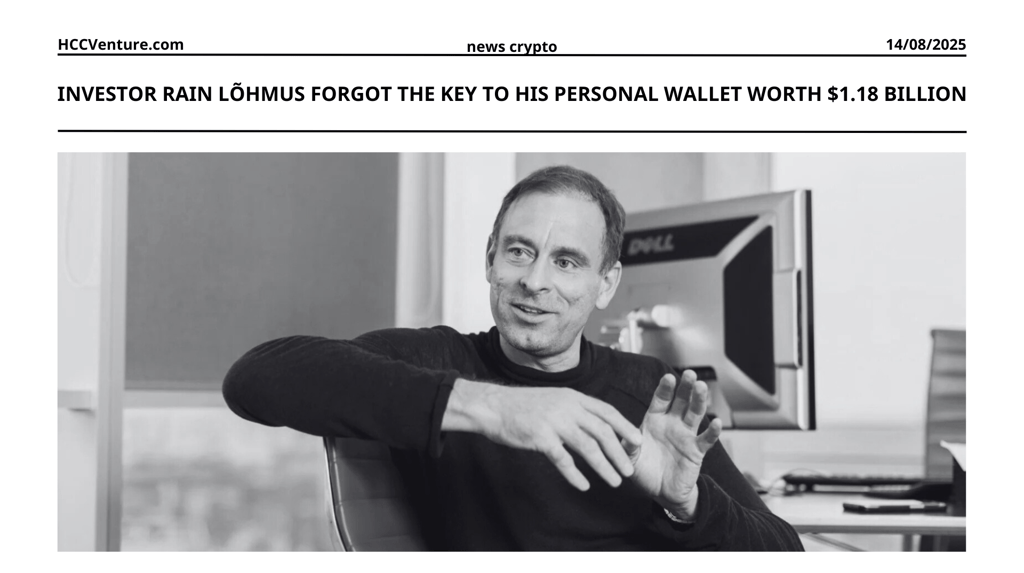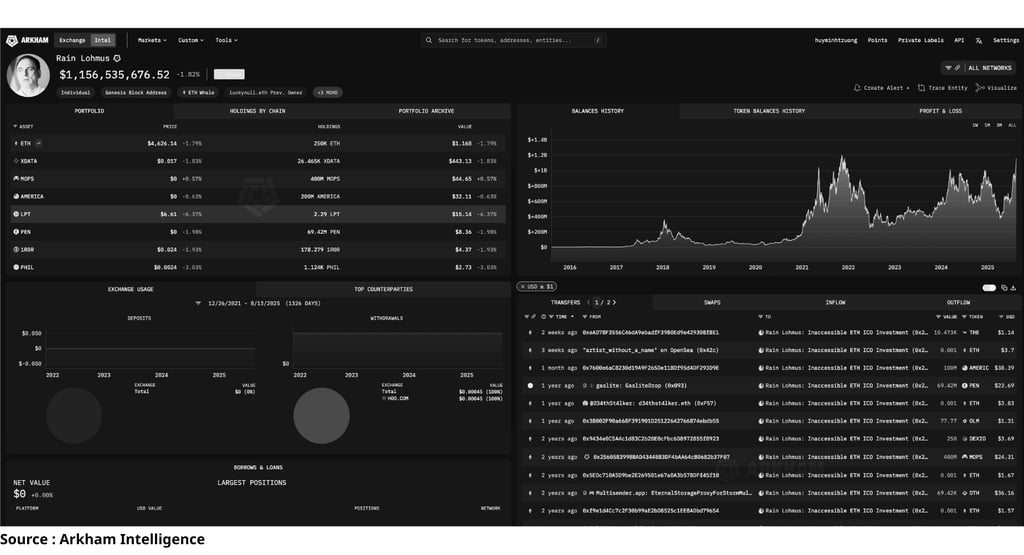Investor Rain Lõhmus forgot the key to his personal wallet worth $1.18 billion
An anonymous investor has lost access to an Ethereum (ETH) wallet containing 25,000 ETH, currently worth approximately $1.18 billion at $4700/ETH (based on recent average prices as of August 14, 2025).
8/14/20253 min read


An unfortunate mistake happened.
Storing assets in decentralized cryptocurrency wallets requires careful management, especially when it comes to private keys and seed phrases. A recent case involving an anonymous investor made headlines when their ETH wallet, which initially contained $75,000 worth of assets, was found to be worth $1.18 billion.
The incident began when someone found an ETH wallet with an address starting with “0xF0e…” and containing 303,000 ETH. At a price of $3,900 per ETH on August 14, 2025, this would be worth about $1.18 billion. On-chain data shows that the wallet first received the 303,000 ETH in July 2015, when the ETH was worth about $0.247, or about $75,000. However, the wallet has not recorded any transactions since then, meaning the investor may have lost access, possibly because they lost their private keys, forgot their recovery phrase, or left the wallet on a broken device.
Tools like Etherscan confirm that the balance has not changed in over 10 years, while the spike in value reflects ETH’s extraordinary growth momentum. This comes amid a tumultuous crypto market, with ETH hitting record highs recently due to demand from staking and institutional accumulation, adding to the attention on this story.


According to the investigation, this wallet is owned by a famous investor in the financial and banking sector, Rain Lohmus, founder of LHV Bank in Estonia and an influential businessman in the traditional finance industry, who accidentally turned the initial investment into a huge fortune but could not access it due to the loss of the private key.
He has been involved in cryptocurrency since its early days, including buying 250,000 ETH during the Ethereum ICO in 2014, but recent information only confirmed that 25,000 ETH was missing from the wallet. The incident was discovered when blockchain analysts noticed that the wallet had not seen any activity since 2015.
The loss of access could have been due to him storing his private keys insecurely, such as on a broken device, a lost notepad, or not having adequate backups. In a previous interview, Lohmus admitted to frequently forgetting passwords, a weakness he said is common but dangerous in decentralized ecosystems.
Accidentally burned over 25,000 ETH tokens
Rain Lohmus’s loss of access to a wallet containing 25,000 ETH, representing approximately 0.053% of the total ETH supply (47 million ETH), is a stark illustration of the security risks in the crypto world. With a current value of $1.18 billion, it is one of the largest individual wallets ever recorded on the blockchain, far surpassing many other well-known wallets. The event not only highlights the meteoric rise in value of ETH – the initial $75,000 has increased more than 15,700-fold in a decade – but also the potential for early investment, albeit with the risk of irreparable loss.
However, because they are inaccessible, these ETH become “locked” assets, unable to be traded or used, reducing the circulating supply on the market. This could put upward pressure on prices in the future, but also raises questions about personal responsibility in managing digital assets.
For the market, the 25,000 ETH locked up could reduce selling pressure, supporting ETH prices in the long term, especially as institutional demand continues to grow with ETF inflows reaching $5.6 billion since April 2025. However, Lohmus is unable to leverage the asset, and this story could lead to a debate about the possibility of a recovery, even though it contradicts the principle of decentralization.
Disclaimer: The information presented in this article is the author's personal opinion on the cryptocurrency field. It is not intended to be financial or investment advice. Any investment decision should be based on careful consideration of your personal portfolio and risk tolerance. The views expressed in the article do not represent the official position of the platform. We recommend that readers conduct their own research and consult with a professional before making any investment decisions.
Explore HCCVenture group
HCCVenture © 2023. All rights reserved.


Connect with us
Popular content
Contact to us
E-mail : holdcoincventure_contact@hccventure.com
Register : https://linktr.ee/holdcoincventure
Disclaimer: The information on this website is for informational purposes only and should not be considered investment advice. We are not responsible for any risks or losses arising from investment decisions based on the content here.


TERMS AND CONDITIONS • CUSTOMER PROTECTION POLICY
ANALYTICAL AND NEWS CONTENT IS COMPILED AND PROVIDED BY EXPERTS IN THE FIELD OF DIGITAL FINANCE AND BLOCKCHAIN BELONGING TO HCCVENTURE ORGANIZATION, INCLUDING OWNERSHIP OF THE CONTENT.
RESPONSIBLE FOR MANAGING ALL CONTENT AND ANALYSIS: HCCVENTURE FOUNDER - TRUONG MINH HUY
Read warnings about scams and phishing emails — REPORT A PROBLEM WITH OUR SITE.
